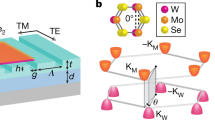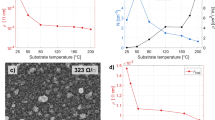Abstract
In applications as diverse as fibre-optic communications and time-domain or terahertz spectroscopy, researchers are keen on ultrafast optoelectronic transducers that can be tailored to specific needs. The molecular beam epitaxy of photoconductors composed of equidistant layers of self-assembled ErAs-islands in a III–V semiconductor matrix, which act as efficient non-radiative carrier capture sites, enables this flexibility. Here, photocurrent autocorrelation techniques are applied to metal–semiconductor–metal photodetectors patterned on ErAs:GaAs superlattices. The experiments demonstrate that the electrical response speed can be conveniently tuned over at least two orders of magnitude starting from 190 fs by increasing the thickness of the GaAs spacer separating adjacent ErAs layers. The same concept is applied to the narrower bandgap InGaAs matrix. We demonstrate an electron lifetime of approximately 1 ps for this material. This brings closer the prospect of implementing terahertz technology at the important optical communication wavelengths of 1.3 and 1.55 μm.
This is a preview of subscription content, access via your institution
Access options
Subscribe to this journal
Receive 12 print issues and online access
$259.00 per year
only $21.58 per issue
Buy this article
- Purchase on Springer Link
- Instant access to full article PDF
Prices may be subject to local taxes which are calculated during checkout





Similar content being viewed by others
References
Verghese, S. et al. Generation and detection of coherent terahertz waves using two photomixers. Appl. Phys. Lett. 73, 3824–3826 (1998).
McIntosh, K.A. et al. Terahertz photomixing with diode lasers in low-temperature-grown GaAs. Appl. Phys. Lett. 67, 3844–3846 (1995).
Kadow, C., Jackson, A.W., Gossard, A.C., Matsuura, S. & Blake, G.A. Self-assembled ErAs islands in GaAs for optical-heterodyne THz generation. Appl. Phys. Lett. 76, 3510–3512 (2000).
Grischkowsky, D., Keiding, S., van Exter, M. & Fattinger, C. Far-infrared time-domain spectroscopy with terahertz beams of dielectrics and semiconductors. J. Opt. Soc. Am. B 7, 2006–2015 (1990).
Verghese, S., McIntosh, K.A. & Brown, E.R. Highly tunable fibre-coupled photomixers with coherent terahertz output power. IEEE Trans. Microwave Theory 45, 1301–1309 (1997).
Chen, P. et al. Spectroscopic applications and frequency locking of THz photomixing with distributed-Bragg-reflector diode lasers in low-temperature-grown GaAs. Appl. Phys. Lett. 71, 1601–1603 (1997).
Auston, D.H. Impulse response of photoconductors in transmission lines. IEEE J. Quantum Electron. 19, 639–648 (1983).
Paulter, N.G., Sinha, D.N., Gibbs, A.J. & Eisenstadt, W.R. Optoelectronic measurements of picosecond electrical pulse propagation in coplanar waveguide transmission lines. IEEE Trans. Microwave Theory 37, 1612–1619 (1989).
David, G. et al. Absolute potential measurements inside microwave digital IC's using a micromachined photoconductive sampling probe. IEEE Trans. Microwave Theory 46, 2330–2337 (1998).
Ferguson, B. & Zhang, X.-C. Materials for terahertz science and technology. Nature Mater. 1, 26–33 (2002).
Kordoš, P., Förster, A., Marso, M. & Rüders, F. 550 GHz bandwidth photodetector on low temperature grown molecular-beam epitaxial GaAs. Electron. Lett. 34, 119–120 (1998).
Burm, J. et al. High-frequency, high-efficiency MSM photodetectors. IEEE J. Quantum Electron. 31, 1504–1509 (1995).
Fay, P. et al. A comparative study of integrated photoreceivers using MSM/HEMT and PIN/HEMT technologies. IEEE Photon. Technol. Lett. 10, 582–584 (1998).
Das, N.R., Basu, P.K. & Deen, M.J., A new approach to the design optimization of HEMT and HBT for maximum gain-bandwidth of MSM-based integrated photoreceiver and its noise performance at 1.55 μm. IEEE Trans. Electron Dev. 47, 2101–2109 (2000).
Kadow, C. et al. Self-assembled ErAs islands in GaAs: Growth and subpicosecond carrier dynamics. Appl. Phys. Lett. 75, 3548–3550 (1999).
Kadow, C., Johnson, J.A., Kolstad, K., Ibbetson, J.P. & Gossard, A.C. Growth and microstructure of self-assembled ErAs islands in GaAs. J. Vac. Sci. Technol. B 18, 2197–2203 (2000).
Look, D.C. Molecular beam epitaxial GaAs grown at low temperatures. Thin Solid Films 231, 61–73 (1993).
Gupta, S., Whitaker, J.F. & Mourou, G.A. Ultrafast carrier dynamics in III-V semiconductors grown by molecular-beam epitaxy at very low substrate temperatures. IEEE J. Quantum Electron. 28, 2464–2472 (1992).
Driscoll, D.C., Hanson, M., Kadow, C. & Gossard, A.C. Electronic structure and conduction in a metal-semiconductor digital composite: ErAs:InGaAs. Appl. Phys. Lett. 78, 1703–1705 (2001).
Driscoll, D.C., Hanson, M., Kadow, C. & Gossard, A.C. Transition to insulating behavior in the metal-semiconductor digital composite ErAs:InGaAs. J. Vac. Sci. Technol. B 19, 1631–1634 (2001).
Pašiškevicius, V., Deringas, A. & Krotkus, A. Photocurrent nonlinearities in ultrafast optoelectronic switches. Appl. Phys. Lett. 63, 2237–2239 (1993).
Jacobsen, R.H., Birkelund, K., Holst, T., Jepsen, P.U. & Keiding, S.R. Interpretation of photocurrent correlation measurements used for ultrafast photoconductive switch characterization. J. Appl. Phys. 79, 2649–2657 (1996).
Brorson, S.D., Zhang, J. & Keiding, S.R. Ultrafast carrier trapping and slow recombination in ion-bombarded silicon on sapphire measured via THz spectroscopy. Appl. Phys. Lett. 64, 2385–2387 (1994).
Iverson, A.E. & Smith, D.L. Mathematical modelling of photoconductor transient response. IEEE Trans. Electron Dev. 34, 2098–2107 (1987)
Grigoras, K., Krotkus, A. & Deringas, A. Picosecond lifetime measurement in semiconductor by optoelectronic autocorrelation. Electron. Lett. 27, 1024–1025 (1991).
Chen, Y., Williamson, S. & Brock, T. 375-GHz-bandwidth photoconductive detector. Appl. Phys. Lett. 59, 1984–1986 (1991).
Kuta, J.J., v an Driel, H.M., Landheer, D. & Adams, J.A. Polarization and wavelength dependence of metal-semiconductor-metal photodetector response. Appl. Phys. Lett. 64, 140–142 (1994).
Kuta, J.J., van Driel, H.M., Landheer, D. & Feng, Y. Polarization dependence of the temporal response of metal-semiconductor-metal photodetectors. Appl. Phys. Lett. 65, 3146–3148 (1994).
Carruthers, T.F. & Weller, J.F. Picosecond optical mixing in fast photodetectors. Appl. Phys. Lett. 48, 460–462 (1986).
Shockley, W. & Read, W.T. Statistics of the recombinations of holes and electrons. Phys. Rev. 87, 835–842 (1952).
Hall, R.N. Electron-hole recombination in germanium. Phys. Rev. 87, 387 (1952).
Acknowledgements
The authors thank R. R. Gerhardts for help with the theoretical description of the experiments. They also acknowledge R. A. Wyss for discussions and M.-H. Stapleton for assistance during the experiments. This research has been supported by the German Science Foundation, the Jet Propulsion Laboratory and QUEST.
Author information
Authors and Affiliations
Corresponding author
Ethics declarations
Competing interests
The authors declare no competing financial interests.
Rights and permissions
About this article
Cite this article
Griebel, M., Smet, J., Driscoll, D. et al. Tunable subpicosecond optoelectronic transduction in superlattices of self-assembled ErAs nanoislands. Nature Mater 2, 122–126 (2003). https://doi.org/10.1038/nmat819
Received:
Accepted:
Published:
Issue Date:
DOI: https://doi.org/10.1038/nmat819
This article is cited by
-
Towards femtosecond on-chip electronics based on plasmonic hot electron nano-emitters
Nature Communications (2018)
-
Static and Dynamical Properties of heavy actinide Monopnictides of Lutetium
Scientific Reports (2016)
-
Characterization of ErAs:GaAs and LuAs:GaAs Superlattice Structures for Continuous-Wave Terahertz Wave Generation through Plasmonic Photomixing
Journal of Infrared, Millimeter, and Terahertz Waves (2016)



